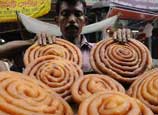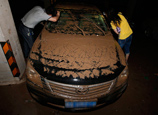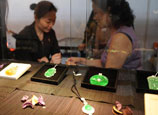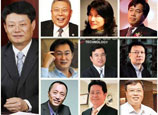
Edited and translated by People's Daily Online
We always talk about cultural consciousness and cultural confidence; however, the question is where the consciousness and confidence come from? One thing is for sure - they do not come from blindly following suit.
This rubber duck with "healing" function has drawn much attention and discussion since it arrived at the Victoria Harbour.
However, in the era of the 3D print technology, the "only one" or "out of print" hardly exists. The popular yellow rubber duck soon had many "identical twin brothers", which are comfortably swimming in the water of Tianjin, Wuhan, Hangzhou and other cities and appearing in countless digital photos with tourists' smiling faces.
For Hofman, the designer of the rubber duck, plenty of meanings are embedded in this work: the culture publicity, childhood memory of many people, relatively pure art and the idea of refusing commercialization. It carries these marks of the designer, appearing in a flash at many places in the world. People can go and have a look, but they cannot make it their own collection; advertisers can dream advertising on it, but they cannot make that happen.
However, for many copiers, the yellow rubber duck has stepped down from the holy place and become a simple symbol with no responsibility of having characteristics. Besides the copyright issue, the various copies of the yellow duck are nothing but film posters seen everywhere in the cities, merely saying "Look! Our city is a fashion metropolitan just like Hong Kong"; or even worse: "Quickly! Our houses are ready, living here would give you the same feeling like living beside the Victoria Harbour, and you could see the yellow duck yourself every single day!"
"Why did you come to Wuhan, you don't even have your neck!" someone on the Internet ridiculed when the yellow duck came to the city famous for its snack "the duck neck". What they said pointed out the connection between culture publicity and culture personality.
The culture of a city needs publicity: public areas, public activities and public cultural cognition. People in the city need parks and libraries; they love to join the chorus on the weekends and dancing at big squares; they would like to listen to high-quality cultural lectures and find some cultural memories in common. In addition, culture building needs to have characteristics, following our traditions and making senses. People go to Wuhan to try "re gan mian" (hot and dry noodles), not "la mian" (hand-pulled noodles); whereas in Lanzhou, if people there follow the trend and sell "Scottish gravy noodles" someday, you would definitely find that boring and tedious.
It is exciting that a funny rubber toy appears in public cultural life. Doing this once in a while perhaps has a "healing" effect, but not too much or too cheap. Following the trend and fashion, mosaic is on those traditional Anhui style buildings; and the Nantian Pillar in Zhangjiajie has been renamed to "Hallelujah Hill". Not speaking of creativity, it even lost our own tradition.
This kind of following trends is definitely cheap. Our creativity would say farewell to the future and our imagination would surrender to the history if we keep following the trends. The more popular the yellow duck gets in Chinese cities, the further we are getting from the ideas of "original creation" and "non-commercial" proposed by Hofman. The more we change our culture to gimmicks, the weaker our creativity will become. The yellow duck's popularity is a good thing, but it would be a tragedy if this reflects the weakness of our imagination.
We always talk about cultural consciousness and cultural confidence; however, the question is where the consciousness and confidence come from. One thing for sure is that they do not come from blindly following suit. Trends and fashion are changing all the time, which make it impossible for us to follow. The only thing we have for real is the land under our feet. We should have our own life, create our own imagination, and make our own "healing" project. We have so much graceful things, from "three hundreds of poems" to "eight great men of letters", from the blue and white porcelain to the corbiestep, from the "Lantern Festival" to the "Dragon Boat Festival". With these beautiful and rich traditions, things we borrow will not be copies.
















 China's Chongqing issues orange-coded alert of heat
China's Chongqing issues orange-coded alert of heat


![]()
